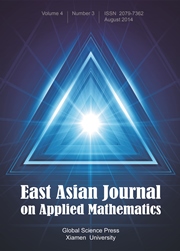Crossref Citations
This article has been cited by the following publications. This list is generated based on data provided by
Crossref.
Li, Dan
Wang, Chunmei
and
Wang, Junping
2020.
Superconvergence of the gradient approximation for weak Galerkin finite element methods on nonuniform rectangular partitions.
Applied Numerical Mathematics,
Vol. 150,
Issue. ,
p.
396.
Zhang, Jiachuan
Li, Jingshi
Li, Jingzhi
and
Zhang, Kai
2020.
An adaptive weak Galerkin finite element method with hierarchical bases for the elliptic problem.
Numerical Methods for Partial Differential Equations,
Vol. 36,
Issue. 6,
p.
1280.
Xu, Shipeng
2021.
A posteriori error estimates for weak Galerkin methods for second order elliptic problems on polygonal meshes.
Applied Numerical Mathematics,
Vol. 161,
Issue. ,
p.
510.
Xie, Yingying
and
Zhong, Liuqiang
2021.
Convergence of Adaptive Weak Galerkin Finite Element Methods for Second Order Elliptic Problems.
Journal of Scientific Computing,
Vol. 86,
Issue. 1,
Mu, Lin
and
Chen, Zheng
2021.
A new WENO weak Galerkin finite element method for time dependent hyperbolic equations.
Applied Numerical Mathematics,
Vol. 159,
Issue. ,
p.
106.
Sharma, Natasha
2021.
Robust a-posteriori error estimates for weak Galerkin method for the convection-diffusion problem.
Applied Numerical Mathematics,
Vol. 170,
Issue. ,
p.
384.
AL-Taweel, Ahmed
and
Mu, Lin
2021.
A new upwind weak Galerkin finite element method for linear hyperbolic equations.
Journal of Computational and Applied Mathematics,
Vol. 390,
Issue. ,
p.
113376.
Liu, Ying
Wang, Gang
Wu, Mengyao
and
Nie, Yufeng
2022.
A recovery-based a posteriori error estimator of the weak Galerkin finite element method for elliptic problems.
Journal of Computational and Applied Mathematics,
Vol. 406,
Issue. ,
p.
113926.
Wang, Huijuan
Xu, Shipeng
and
He, Xiaoxiao
2022.
A Posteriori Error Estimates of Edge Residual-Type of Weak Galerkin Mixed FEM Solving Second-Order Elliptic Problems on Polytopal Mesh.
International Journal of Computational Methods,
Vol. 19,
Issue. 05,
Qi, Wenya
and
Song, Lunji
2023.
An over-penalized weak Galerkin method for parabolic interface problems with time-dependent coefficients.
Journal of Computational and Applied Mathematics,
Vol. 422,
Issue. ,
p.
114883.
Chen, Luoping
Dai, Jiajia
and
Wen, Yiming
2023.
A posteriori error estimates of two-grid weak Galerkin methods for semilinear elliptic differential equations.
Applied Numerical Mathematics,
Vol. 187,
Issue. ,
p.
277.
Yingying, Xie
Cao, Shuhao
Chen, Long
and
Zhong, Liuqiang
2023.
Convergence and optimality of an adaptive modified weak Galerkin finite element method.
Numerical Methods for Partial Differential Equations,
Vol. 39,
Issue. 5,
p.
3847.
Zhang, Jiachuan
Zhang, Ran
and
Li, Jingzhi
2023.
A Posteriori Error Estimator for Weak Galerkin Finite Element Method for Stokes Problem Using Diagonalization Techniques.
Computational Methods in Applied Mathematics,
Vol. 23,
Issue. 3,
p.
783.
Zhang, Yongchao
Mei, Liquan
and
Wang, Gang
2023.
A Posteriori Error Analysis of the Hybrid High-Order Method for the Stokes Problem.
Journal of Scientific Computing,
Vol. 96,
Issue. 3,
Liu, Chunmei
Xie, Yingying
Zhong, Liuqiang
and
Zhou, Liping
2024.
A posteriori error estimate of a weak Galerkin finite element method for solving linear elasticity problems.
Computers & Mathematics with Applications,
Vol. 173,
Issue. ,
p.
47.
Zhang, Min
Zhang, Tong
and
Xie, Xiaoping
2024.
Robust globally divergence-free Weak Galerkin finite element method for incompressible Magnetohydrodynamics flow.
Communications in Nonlinear Science and Numerical Simulation,
Vol. 131,
Issue. ,
p.
107810.
Xu, Shipeng
2024.
A posteriori error estimate of the weak Galerkin finite element method solving the Stokes problems on polytopal meshes.
Numerical Methods for Partial Differential Equations,
Vol. 40,
Issue. 5,
Dai, Jiajia
and
Chen, Luoping
2024.
Convergence of adaptive two-grid weak Galerkin finite element methods for semilinear elliptic differential equations.
Communications in Nonlinear Science and Numerical Simulation,
Vol. 130,
Issue. ,
p.
107709.
Wang, Ruiwen
Song, Lunji
and
Liu, Kaifang
2024.
A new over-penalized weak Galerkin method. Part Ⅲ: Convection-diffusion-reaction problems.
Discrete and Continuous Dynamical Systems - B,
Vol. 29,
Issue. 4,
p.
1652.


